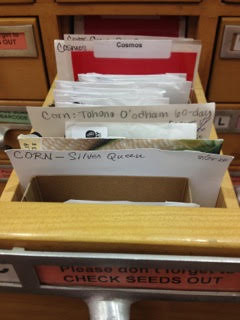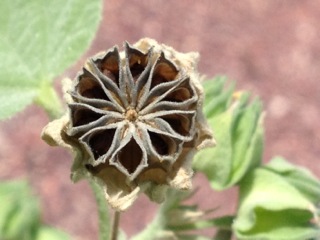By Gail Ryser
At this year’s WARP Annual Meeting Kathleen Vitale’s presentation Challenges of Documenting the Maya Textile Tradition sparked a lively discussion on the effects of Monsanto’s seed policies for growers of indigenous brown cotton. This is in response to that discussion.
I am a seed saver and have been doing so for most of my life. In the past I collaborated with scientists at the Instituto Peruano del Algodon in Peru for their quest to preserve the genomes of Peru’s native colored cotton varieties. These days I save seeds from my vegetable garden and from the native plants that grow in my yard and around my neighborhood. I am able to share these with neighbors or other garden enthusiasts at our local food bank seed swap events.
Saving seeds and sharing them with others has been an important practice that helped sustain us as a species for thousands of years, since the beginning of agricultural practices. Through seed saving practices, gardeners, small-scale farmers, agriculturalists and eventually small, independent seed companies specialized in open pollinated plant and crop varieties that were well suited to local environments. These practices also created a vast array of crop varieties and allowed communities to conserve, preserve, grow, and promote local seed diversity and cultural heritage.
Alarmingly, since the early 1900’s in the US, we have witnessed a 75% to 90% decline in crop diversity. This is a problem! Diversity is like an insurance policy against extinction. The loss is due in part from advances in biotechnology resulting in GMO (genetically modified organism) and hybrid seeds and multinational corporations absorbing independent, regionally based seed companies while at the same time gaining monopolies on seed and seed distribution. These corporations use the notion of intellectual property rights to gain patent rights on crops containing modified traits. This directly affects the farmers who, no longer are allowed to exercise sovereignty over seeds produced in their fields without patent infringement and other consequences such heavy fines, lawsuits or in some extreme cases, imprisonment.
Seeds are the first step in our fiber and food systems. Whoever controls the seeds controls the access. I recently attended the 1st International Seed Library Forum1 held in Tucson, AZ. This movement is gaining momentum in the US and across the globe; North America has over 300 recognized seed libraries. A seed library has many elements in common with a traditional book library. Patrons check out seeds. While each library will have its inherently individual focus specific to the community it serves, seed libraries have in common these 3 universal motivations: 1) biological diversity, 2) food access and security, and 3) culture, community and the role of story.
At risk is our sovereign right to collect, to save, and to share seeds and their stories. The fight to control access to seeds goes beyond monopolies of multinational corporations and is coming to our back yards. Last year a seed library in Pennsylvania was closed due to the misapplication of commercial seed laws. Other libraries face similar regulatory challenges. If those laws were applied in the state where I live I would be arrested for sharing seeds with my neighbors or donating to the seed library.
There is no doubt in my mind the importance of maintaining biological diversity and creating regionally specific varieties. Just as there is no doubt in my mind the importance of safeguarding our food and fiber seeds to ensure that there will be a future of both biological and cultural heirlooms grown from our fields of today.
Other links:
http://www.seedbroadcast.org/SeedBroadcast/SeedBroadcast.html




